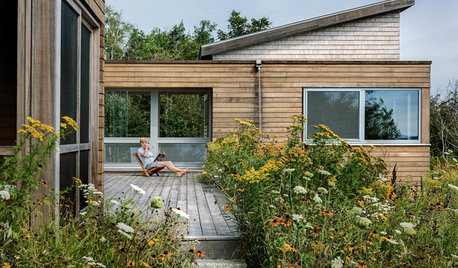sweet cherry tree help
pawsitive_gw
15 years ago
Related Stories

GARDENING GUIDESPlant Black Cherry Trees for the Birds and Bees
Plant Prunus serotina in the Central and Eastern U.S. for spring flowers, interesting bark and beautiful fall color
Full Story
EDIBLE GARDENSHow to Grow Your Own Luscious Cherries
Nope, they’re not the easiest fruit to grow. But with spectacular blossoms and pies as possibilities, cherries are sure worth a try
Full Story
PINKCherry Blossom Pink Romances Rooms
Let the sweet nature of your rooms bloom with this prettiest of colors
Full Story
PRODUCT PICKSGuest Picks: Help Your Home Blossom With Floral Decor
Sprinkle hints of spring around your rooms with fabrics, wall coverings and more that recall nature's charms
Full Story
COLORPick-a-Paint Help: How to Create a Whole-House Color Palette
Don't be daunted. With these strategies, building a cohesive palette for your entire home is less difficult than it seems
Full Story
LANDSCAPE DESIGNNative Plants Help You Find Your Garden Style
Imagine the garden of your dreams designed with plants indigenous to your region
Full Story
GARDENING GUIDESSpring Citrus Care Reaps Months of Sweet Rewards
Learn how to tend citrus trees in spring and ways to preserve their delicious fruit
Full Story
EDIBLE GARDENSGrow Plum Hybrids for Your Favorite Fruit Flavors
Plums are cozying up with apricots, peaches and even cherries — here’s how to grow these hybrids for the best aspects of each
Full Story
GARDENING GUIDES3 Ways to Revel in Summer Garden Sweetness
Patiently observe what works and doesn’t work in your landscape
Full Story
EDIBLE GARDENSHow to Grow Your Own Sweet Summer Crops
This guide will help any gardener get started on growing the freshest warm-season veggies and berries for summer
Full Story





psittacine
pawsitive_gwOriginal Author
Related Professionals
Fort Lee Landscape Architects & Landscape Designers · Hyattsville Landscape Architects & Landscape Designers · Canyon Lake Landscape Contractors · Mesa Landscape Contractors · Norwalk Landscape Contractors · Nutley Landscape Contractors · Panama City Beach Landscape Contractors · Reedley Landscape Contractors · Santa Ana Landscape Contractors · Wareham Landscape Contractors · Weymouth Landscape Contractors · Vadnais Heights Landscape Contractors · Amesbury Siding & Exteriors · Panama City Siding & Exteriors · Franklin Square Siding & Exteriorsstevation
psittacine
stevation